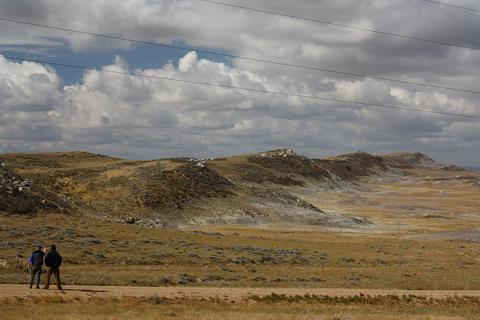- Home
- Encyclopedia
- Como Bluff
Como Bluff
Como Bluff Historic Paleontological Site is located along U. S. Highway 30/287 in Carbon and Albany counties, Wyo., on private property. Trespassing is not allowed.

Historically this site was mined for fossils; today, it is seldom visited by paleontologists. Como Bluff remains important for its education and science opportunities, however. Dinosaur discoveries at Como Bluff, beginning in the late 1870s, played a very important role in the “development of many of the great museums of the New World,” according to author Ned Frost who wrote the document nominating this site to the National Register of Historic Places. Hundreds of bones were unearthed and shipped from this site to different locations around the world.
During the Cretaceous and Jurassic time periods (65-180 million years ago) this area looked, and felt, quite different than it does today. The temperature was much warmer and the climate wetter; the land was flatter. These conditions would have favored many animals, including dinosaurs, as represented by the fossil record. Today, the land is dry and windblown.
Como Bluff is part of an anticline, a geological formation where the rock layers on a long axis--east to west in this case--were bent upward. Later, the middle of the anticline eroded away, leaving two long flanks, north and south. Como Bluff is the south flank of the anticline, with the dinosaur-bone-bearing rock layers exposed on its steep, north side.
Here, paleontologists found many fossil specimens in near‑perfect condition. During the late 1870s and 1880s, paleontology teams from Yale University and the Philadelphia Academy of Natural Sciences discovered a multitude of dinosaur and other prehistoric animal remains here. Some dinosaurs found at this site were: Allosaurus, Stegosaurus, Camarasaurus, Diplodocus and Apatosaurus, known then as Brontosaurus Dinosaurs from Como Bluff are on display at the Peabody Museum at Yale, the Smithsonian Institution’s National Museum of Natural History in Washington, D.C., and the American Museum of Natural History in New York City.
More history about the dinosaurs found at Como Bluff, the people involved and the past activities that occurred at this site may be found in the nomination to the National Register of Historic Places. Nominations can be obtained online by searching the following website: http://wyoshpo.state.wy.us/NationalRegister/Search.aspx, or by contacting the Wyoming State Historic Preservation Office at (307) 777-7697.
Resources
Frost, Ned. Como Bluff National Register of Historic Places Nomination Form, Albany and Carbon County files, 9 November 1971. Cheyenne: Wyoming State Historic Preservation Office.
For further reading
Wallace, David Rains. The Bonehunters’ Revenge: Dinosaurs, Greed, and the Greatest Scientific Feud of the Gilded Age. Boston: Houghton Mifflin Company, 1999.
Rea, Tom. Bone Wars: The Excavation and Celebrity of Andrew Carnegie’s Dinosaur. Pittsburgh: University of Pittsburgh Press, 2001, 2004.
Brinkman, Paul. The Second Jurassic Dinosaur Rush: Museums and Paleontology in America at the Turn of the Twentieth Century. Chicago: University of Chicago Press, 2010.
Illustrations
The photo of the north face of Como Bluff is by Tom Rea.
